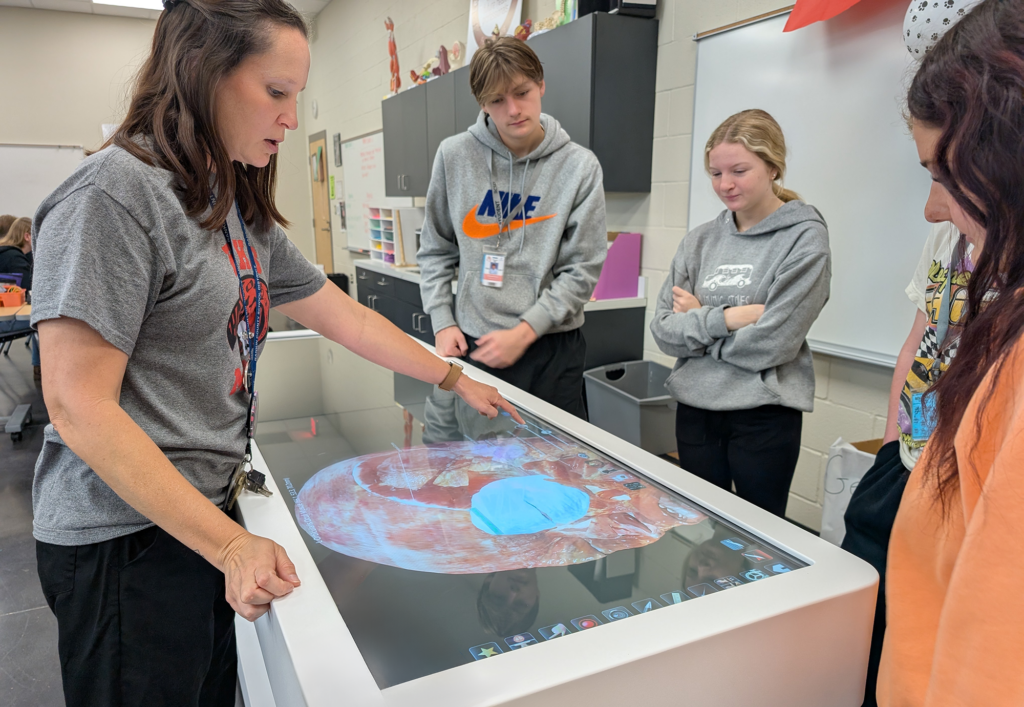Home »
Florence High School Invests in Future Healthcare Professionals with New Technology
04/09/2025
FLORENCE, Miss. — Florence High School’s Medical Science Academy is redefining how students explore careers in healthcare. Through immersive, hands-on learning and real-world experiences, the program is equipping students with the skills and confidence they need to pursue futures in medical fields.
A boost to the program came through nearly $30,000 in funding from the EquipMS Grant. With this support, the school has been able to elevate its curriculum and provide students with unprecedented access to medical technology, including the Anatomage Table— a cutting-edge virtual dissection tool once found mainly in higher learning medical education programs.
“We were doing everything we could to raise money,” said Kira Berch, Ed.S, LAT, ATC, Athletic Trainer and CPR Instructor at Florence High School. “We formed a booster club, led fundraisers, begged and pleaded—offered community service hours to kids who helped sell. In the end, we were the ones out there promoting. This grant really took us to the next level.”
The EquipMS Grant program, created through House Bill 588 (2023) as part of the Mississippi K-12 Workforce Development initiative, is designed to help public school districts modernize and enhance high school career and technical education (CTE) programs in priority sectors—including healthcare.
Launched in 2012, the academy was initially established to provide students in rural communities with access to medical career training—an opportunity that many would not otherwise have. What started with just three participating schools has now expanded to nearly the entire district.
The program provides students with essential knowledge in medical terminology, anatomy, physiology, and practical healthcare skills. It also functions as a vital discovery platform, assisting students in exploring various career paths before committing to post-secondary education.
The program stands out for its strong ties with local healthcare providers, giving students hands-on experience through job shadowing, clinical support, and even opportunities to observe live surgeries.
“We have a lot of local clinics, dentists, and physical therapy centers that take our kids regularly,” said Dr. Danielle Traylor, Ed.D, LAT, ATC, Health Science Instructor. “They’re really good about working with them. Sometimes students also find their own opportunities, and they come back so excited because they got to see something real.”
Along with clinical experiences, students develop professional skills such as patient confidentiality, bedside manners, and medical ethics. Some go on to secure entry-level healthcare jobs right after graduation, while others pursue college programs—often earning scholarships in fields like nursing and athletic training.
The introduction of the Anatomage Table has revolutionized how students engage with anatomy. This state-of-the-art technology gives them access to real human cadaver scans, CT and MRI images, and lifelike 3D anatomical models—turning traditional, two-dimensional textbook learning into a fully immersive, interactive experience.
“Having the Anatomage Table really helps me visualize all of the lessons that I am taught in the Health Science Academy,” said sophomore Sarah Avery Christman. “The table makes learning the functions, anatomy, and physiology of the human body 100 times easier than it would be from a textbook!”
“Before we had the table, all we really had were images in textbooks or maybe a video,” said Traylor. “Now, students can see real human cadavers in 3D. They can dissect layer by layer, zoom in, rotate, and interact with the body in a way that wasn’t possible before.”
“This is about as close as these kids will ever get to a real dissection unless they go to med school,” she added. “It’s overwhelming at first, but it’s also exciting. The students love it—they’d be back there all the time if we let them.”
With this technology, lessons go far beyond the textbook. Students can virtually dissect the body, explore organ systems, and even observe medical events like childbirth and heart rhythms. Since introducing the table, other schools in the district have begun adopting it as well.
“Our goal is to either motivate students to continue in the healthcare field or help them realize it’s not for them—before they spend thousands of dollars on a degree they won’t use,” Berch explained.
Graduates often credit the program with giving them a head start in college-level coursework, especially in subjects like anatomy and physiology. Many report excelling in college thanks to the foundation built at Florence High School.
“Every year, we get calls from former students saying, ‘That anatomy and physiology class in college was so easy because of what you taught us,’” said Traylor. “They don’t realize it at the time, but once they’re in college, they see the difference.”
“We can’t certify students to be nurses or doctors in high school,” Berch added, “But we can give them a head start. We introduce them to the medical field, teach them critical skills, and help them figure out if this is really what they want to do.”
With strong community partnerships, growing student interest, and continued investment in innovative tools, the Health Science Academy at Florence High School stands as a model for career-focused education.
By offering early, immersive exposure to healthcare careers, the program is not just preparing students for the future—it’s transforming lives.

AccelerateMS serves the people and businesses of Mississippi by developing and deploying workforce strategies to connect individuals with transformative, high-paying careers. By leveraging resources and partnering with organizations that hold complementary missions, AccelerateMS effectuates positive change, creating sustained individual, community, and statewide economic prosperity.
